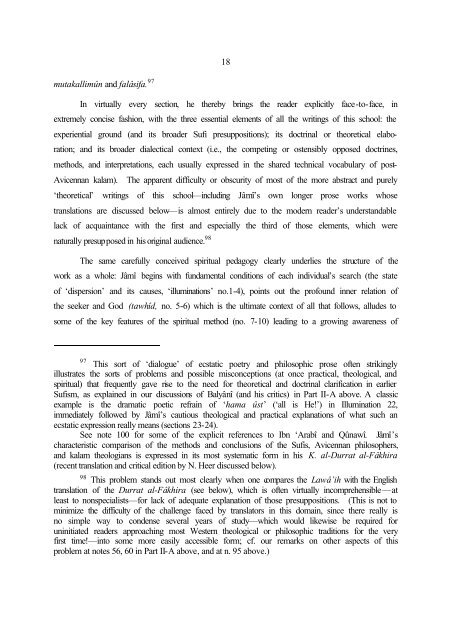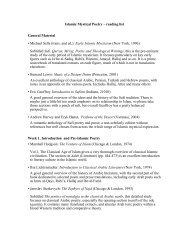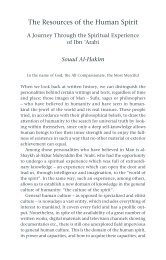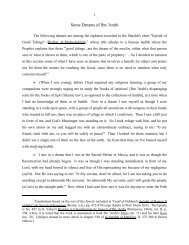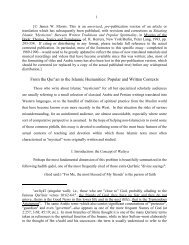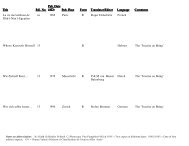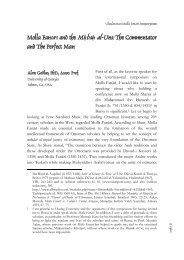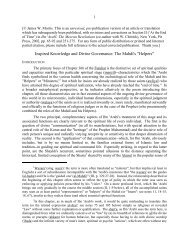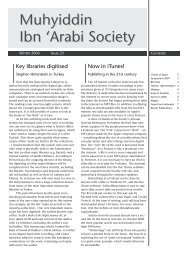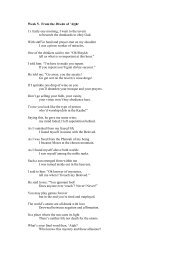Part III (pdf) - Muhyiddin Ibn Arabi Society
Part III (pdf) - Muhyiddin Ibn Arabi Society
Part III (pdf) - Muhyiddin Ibn Arabi Society
You also want an ePaper? Increase the reach of your titles
YUMPU automatically turns print PDFs into web optimized ePapers that Google loves.
18mutakallimûn and falâsifa. 97In virtually every section, he thereby brings the reader explicitly face-to-face, inextremely concise fashion, with the three essential elements of all the writings of this school: theexperiential ground (and its broader Sufi presuppositions); its doctrinal or theoretical elaboration;and its broader dialectical context (i.e., the competing or ostensibly opposed doctrines,methods, and interpretations, each usually expressed in the shared technical vocabulary of post-Avicennan kalam). The apparent difficulty or obscurity of most of the more abstract and purely‘theoretical’ writings of this school—including Jâmî’s own longer prose works whosetranslations are discussed below—is almost entirely due to the modern reader’s understandablelack of acquaintance with the first and especially the third of those elements, which werenaturally presupposed in his original audience. 98The same carefully conceived spiritual pedagogy clearly underlies the structure of thework as a whole: Jâmî begins with fundamental conditions of each individual’s search (the stateof ‘dispersion’ and its causes, ‘illuminations’ no.1-4), points out the profound inner relation ofthe seeker and God (tawhîd, no. 5-6) which is the ultimate context of all that follows, alludes tosome of the key features of the spiritual method (no. 7-10) leading to a growing awareness of97This sort of ‘dialogue’ of ecstatic poetry and philosophic prose often strikinglyillustrates the sorts of problems and possible misconceptions (at once practical, theological, andspiritual) that frequently gave rise to the need for theoretical and doctrinal clarification in earlierSufism, as explained in our discussions of Balyânî (and his critics) in <strong>Part</strong> II-A above. A classicexample is the dramatic poetic refrain of ‘hama ûst’ (‘all is He!’) in Illumination 22,immediately followed by Jâmî’s cautious theological and practical explanations of what such anecstatic expression really means (sections 23-24).See note 100 for some of the explicit references to <strong>Ibn</strong> ‘Arabî and Qûnawî. Jâmî’scharacteristic comparison of the methods and conclusions of the Sufis, Avicennan philosophers,and kalam theologians is expressed in its most systematic form in his K. al-Durrat al-Fâkhira(recent translation and critical edition by N. Heer discussed below).98This problem stands out most clearly when one compares the Lawâ’ih with the Englishtranslation of the Durrat al-Fâkhira (see below), which is often virtually incomprehensible—atleast to nonspecialists—for lack of adequate explanation of those presuppositions. (This is not tominimize the difficulty of the challenge faced by translators in this domain, since there really isno simple way to condense several years of study—which would likewise be required foruninitiated readers approaching most Western theological or philosophic traditions for the veryfirst time!—into some more easily accessible form; cf. our remarks on other aspects of thisproblem at notes 56, 60 in <strong>Part</strong> II-A above, and at n. 95 above.)


